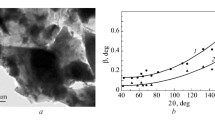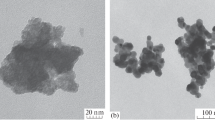Data are studied and summarized for sintering kinetics of different zirconium dioxide powders, stabilized with yttrium and cerium oxides. It is shown that a study of pressed (or prepared by other compaction methods) billets in a SENTSYS Evolution 24 (Sentaram, France) thermomechanical analyzer/dilatometer makes it possible, without recourse to prolonged and energy consuming series of regimes in high-temperature furnaces, to optimize powder sintering parameters and makes it possible to predict the behavior of materials with different heat treatment conditions.






Similar content being viewed by others
References
O. V. Al’myasheva, É. N. Korytkova, A. V. Maslov, et al., “Preparation of aluminum oxide nanocrystals under hydrothermal conditions,” Neorgan. Materialy, 41(5), 540–547 (2005).
M. J. Šæepanoviæ, M. Grujiæ-Brojèin, Z. D. Dohèeviæ-Mitroviæ, et al., “Characterization of anatase TiO2 nanopowder by variable-temperature Raman spectroscopy,” Sci. Sintering, 41, 67–73 (2009).
A. S. Vanetsev and Yu. D. Tret’yakov, “Microwave synthesis of individual and multicomponent oxides,” Uspekhi Khimii, 76(5), 435–453 (2007).
E. S. Lukin, N. A. Makarov, A. I. Kozlov, et al., “Nanopowders for preparing a new generation of oxide ceramics,” Refr. Indus. Ceram., 50(6), 425–430 (2009).
A. V. Shevchenko, E. V. Dudnik, A. K. Rubin, et al., “Hydrothermal synthesis of nanocrystalline powder in the system ZrO2–Y2O3–CeO2,” Poroshk. Metall. No. 1/2, 23–30 (2007).
V. V. Popov and V. F. Petrunin, “Study of metastable phase formation and stability in nanocrystalline ZrO2,” Ogneupor. Tekhn. Keram., No. 8, 8–13 (2007).
C. Y. Chen, T. K. Tseng, S. C. Tsai, et al., “Effect of precursor characteristics on zirconia and ceria particle morphology in spray pyrolysis,” Ceram. Internat., 34, 409–416 (2008).
S. K. Tadokoro and E. N. S. Muccillo, “Physical characteristics and sintering behavior of ultrafine zirconia-ceria powders,” J. Europ. Ceram. Soc., 22, 1723–1728 (2002).
V. B. Kul’met’eva, S. E. Porozova, B. L. Krasnyi, et al., “Preparation of zirconia ceramics from powder synthesized by a sol-gel method,” Refr. Indus. Ceram., 50(6), 438–440 (2009).
V. N. Antsiferov, G. V. Bobrov, L. K. Druzhinin, et al., “Powder Metallurgy and Coating Deposition Higher Education Textbook [in Russian], Metallurgiya, Moscow (1987).
N. G. Rambidi and A. V. Berezkin, Physical and Chemical Bases of Nanotechnology [in Russian, FIZMATLIT, Moscow (2006).
V. B. Kul’met’eva, S. E. Porozova, and E. S. Gnedina, “Synthesis of nanocrystalline zirconium dioxide, stabilized with yttrium oxide, for low-temperature sintering,” Izv. Vyssh. Uchebn. Zaved., Poroshk. Metall. Funkts. Pokryt., No. 2, 3–9 (2011).
V. N. Antsiferov, S. E. Porozova, and V. B. Kul’met’eva, “Effect of water soluble polymer additives on the phase composition and size of zirconia particles during precipitation from salt solutions,” Glass Phys. Chem., 38(3), 322–326 (2012).
S. E. Porozova, V. B. Kul’met’eva, I. R. Ziganyshin, et al., “Comparative characteristics of the results of determining monoclinic phase content in zirconium dioxide,” Vopr. Materialovedeniya, 61(1), 46–52 (2010).
M. Mazaheri, A. Simchi, and F. Golestani-Fard, “Densification and grain growth of nanocrystalline 3Y-TZP during two-step sintering,” J. Europ. Ceram. Soc., 28, 2933–2939 (2008).
S. V. Markov and I. R. Ziganyshin, “Variation of material porosity based on zirconium dioxide prepared by gel casting,” Chemistry and Technology of New Substances and Materials: Proc. II All-Russia Youth Sci. Conf., 14–16 May, 2012. Syktyvkar Komi NTs UrO RAN, Syktyvkar (2012).
S. Ye. Porozova, V. B. Kulmetyeva, and I. R. Ziganshin, “Molding of zirconia-based heat-resistant materials with nanoporosity and microporosity,” Nanomaterials Yearbook-2009. From Nanostructures, Nanomaterials, and Nanotechnologies to Nanoindustry, Nova Science Publishers, New York (2009).
I. R. Zigan’shin,, S. Ye. Porozova, V. I. Karmanov, et al., “Change in industrial zirconium oxide powder and material properties based on mechanochemical activation,” Izv. Vyssh. Uchebn. Zaved., Poroshk. Metall. Funkts. Pokryt., No. 4, 11–15 (2009).
I. R. Zigan’shin, S. E. Porozova, and Yu. F. Trapeznikov, “Preparation of porous material based on nanodispersed powder ZrO2 – 15 mol.% CeO2,” Vopr. Materialovedeniya, No. 4, 79–84 (2010).
O. V. Karban’, E. N. Khazanov, O. L. Khasanov, et al., “Inheritance and modification of nanostructured ZrO2 ceramic during manufacture,” Perspekt. Materialy, No. 6, 76–85 (2010).
Author information
Authors and Affiliations
Additional information
Translated from Novye Ogneupory, No. 8, pp. 15 – 19, August, 2013.
Rights and permissions
About this article
Cite this article
Porozova, S.E., Kul’met’eva, V.B., Gurov, A.A. et al. Thermomechanical Analysis as a Tool for Optimizing Sintering Regimes for Ceramic Materials based on Zirconium Dioxide. Refract Ind Ceram 54, 307–311 (2013). https://doi.org/10.1007/s11148-013-9599-2
Received:
Published:
Issue Date:
DOI: https://doi.org/10.1007/s11148-013-9599-2




